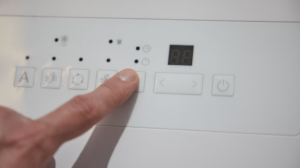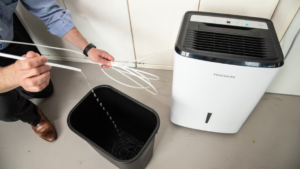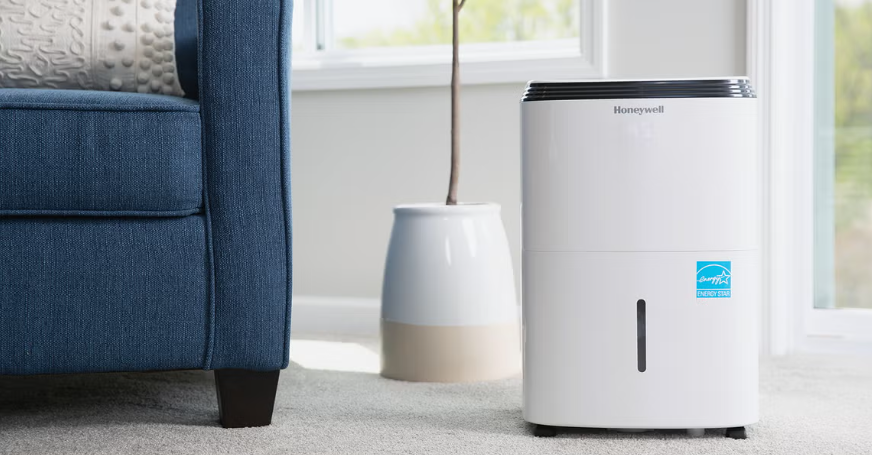Running a dehumidifier is the fastest, easiest way to control high humidity in your home, making your place more comfortable, while preventing the spread of mold, mildew, dust mites and other harmful contaminants. Though summer is high season for dehumidifier use in most parts of the country, many consumers rely on the machines throughout the year — for example, to dry out perpetually dank basements.
In this buying guide, we walk you through all the decisions that go into finding the perfect dehumidifier for your needs.Trust us when we say, this is not a one-size-fits-all category. A unit that’s too small for your space will never pull enough moisture from the air, no matter how solid its drying performance. Certain features can be critical too, like a frost control sensor if the dehumidifier will live in a chilly basement.

Types of dehumidifiers
All dehumidifiers use the same basic mechanics — an internal fan pulls air from the room over refrigerated coils, which drop the converted droplets into a tank. The key distinction is how much moisture they can remove from the air in a 24-hour span. Though brands don’t always label models this way, our experts group dehumidifiers into three categories: small, medium and large. Here’s what you need to know about each.
✔️ Small-capacity dehumidifiers: Dehumidifiers in this category typically remove between 20 and 30 pints of moisture per day. Our experts recommend them for areas up to 600 square feet. Because of their limited capacity, they perform best in spaces that get damp, but not wet. In other words, if you have a 500-square-foot basement with condensation on the walls or seriously musty smells, you’re better off moving to a medium-capacity unit. Features in the small-capacity category tend to be more limited, though that helps keeps costs down, with many units priced below $200.
✔️ Medium-capacity dehumidifiers: For spaces between 600 and 800 square feet, our experts recommend medium-capacity dehumidifiers, which are designed to capture 30 to 40 pints per day. These models often hit the sweet spot between drying performance, energy efficiency and quiet operation. We also see more convenience features in this category, including auto-defrost and easy-access reservoir buckets. Expect to spend between $200 and $300 for a top-performing mid-sized dehumidifier.

✔️ Large-capacity dehumidifiers: If you’re dealing with a large area with serious humidity issues (standing water on the floor, chronic musty smells, etc.), opt for a large-capacity dehumidifier, even if it means spending $300 or more. The units can remove 40 pints of water per day or more and many are fully featured. That includes the option of a built-in pump, helpful if you want to continuously drain water to an elevated location, like a utility sink. The tradeoff for that exceptional performance is increased energy use and noisier operation, plus the bulky units take up more floor space.
✔️ Whole-house dehumidifiers: This is a different animal from portable dehumidifiers, but it’s worth knowing about. Whole-house dehumidifiers work as add-ons to a home’s existing forced-air heating and cooling system. They pull moisture from the air as it circulates through the house. The systems must be professionally installed, at an average cost of $1,500, according to ANGI, the home services marketplace. But they work automatically and they’re capable of maintaining optimal humidity levels in homes as large as 5,000 square feet.
What to look for when shopping
Though choosing the right size humidifier for your needs is the critical first step, there are other factors to consider. Here’s what you need to think about.
✔️ Accuracy: When it comes to humidity levels in the home, it’s best to stay below 50%, the point at which mold, mildew and other bacteria start to thrive. The best humidifiers in our tests have an accurate humidistat that can hold humidity levels in the room at the desired set point.
✔️ Frost control: This feature is a must for dehumidifiers that will live in a space where freezing temperatures occur, since the chill can cause frost to form on the refrigerator coils, making them unable to pull moisture from the air (though the internal fan will keep running). A frost control sensor will turn the dehumidifier off automatically when temperatures get too cold, preventing damage to the machine, as well as wasted energy.

✔️ Drainage options: If you’re trying to dry out a small space with only mild humidity, you might not mind emptying the tank by hand every few days. But in large, damp spaces, continuous draining is a nice option. For this, you’ll need a model with a hose connection that diverts condensed water to a floor drain or other exit point. In this case, spending more on a dehumidifier with a built-in pump that will make it possible to send the water to a utility sink or other elevated location may be worth it.
✔️ Noise: This might be less of an issue if you plan to place the unit in a basement or other seldom used part of the house. But if the dehumidifier will live in a bedroom, dorm room or the like, consider how loud the machine gets. Models that operate at 50 decibels or below on their highest fan speeds get top marks in our tests; anything above 60 decibels could be a nuisance at night.
✔️ Energy efficiency: As a rule, the bigger the dehumidifier, the more energy it will consume. But even within each category (small, medium and large), some models use more energy than others. Dehumidifiers that carry the Energy Star label will use 13% less energy than similarly sized units without the designation. The EPA, which runs the Energy Star program, also has a Most Efficient label for dehumidifiers that achieve maximum efficiency.
✔️ Convenience: Dehumidifiers that prove easy to operate and maintain in our tests have a few key features. Intuitive, digital controls help you choose the right humidity setting and fan speed. A front-facing bucket with a comfortable handle makes for easy removal when dumping water. A filter indicator light reminds you to clean your machine’s air filter. A timer lets you program the dehumidifier to turn off when you’re away from home. Wi-Fi-connectivity and a user-friendly app that allows you to monitor and control the machine remotely are nice-to-haves, our experts say, but not essential.
How do dehumidifiers work?
A dehumidifier is a simple piece of engineering, so a quality model should deliver many years of service. It consists of two heat exchangers and a condenser which pulls moisture from humid air. An interior fan draws air from the room into the first heat exchanger and trades heat for a refrigerant in the exchanger. This causes the air to drop below its dew point, or the temperature at which condensation starts to form.
This condensation is then deposited into the dehumidifier’s reservoir. The evaporated coolant flows into a condenser where it returns to its liquid form; the heat produced in the process is absorbed back by the air. This way, cold air isn’t coming off the dehumidifier. The air that leaves a dehumidifier will always be slightly hotter than the air that enters.
What’s the best way to clean a dehumidifier?
Cleaning your dehumidifier is critical to prevent mold spores and other allergens from breeding inside. How often you clean it depends on the level of humidity in your home as well as the air quality. A few times a month might be necessary during peak humidity.
Start by removing the filter and cleaning it according to the manufacturer’s instructions. Many recommend a simple sponge-clean at the sink with soap and water; let the filter dry completely before reinserting it.
Next, remove the reservoir and give it a deep clean it with hot, soapy water. For good measure, spray it with a solution of equal parts distilled vinegar and water to help inhibit bacteria growth.
Finally, wipe down the exterior housing of the dehumidifier with a sponge or cloth. It’s also a good idea to clean the grill at the back of the unit. Some manufacturers recommend a soft-bristled brush to remove dust and debris, or you might be able to use the nozzle attachment on your vacuum.



